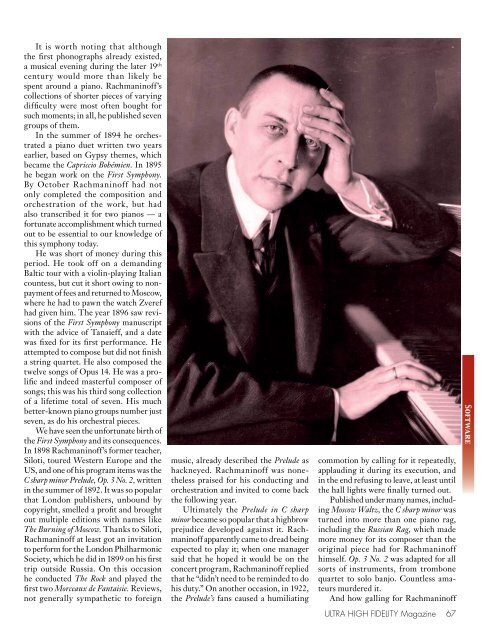A Terrific Tube Preamplifier From Korea, And A - Ultra High Fidelity ...
A Terrific Tube Preamplifier From Korea, And A - Ultra High Fidelity ...
A Terrific Tube Preamplifier From Korea, And A - Ultra High Fidelity ...
You also want an ePaper? Increase the reach of your titles
YUMPU automatically turns print PDFs into web optimized ePapers that Google loves.
It is worth noting that although<br />
the first phonographs already existed,<br />
a musical evening during the later 19 th<br />
century would more than likely be<br />
spent around a piano. Rachmaninoff’s<br />
collections of shorter pieces of varying<br />
difficulty were most often bought for<br />
such moments; in all, he published seven<br />
groups of them.<br />
In the summer of 1894 he orchestrated<br />
a piano duet written two years<br />
earlier, based on Gypsy themes, which<br />
became the Capriccio Bohémien. In 1895<br />
he began work on the First Symphony.<br />
By October Rachmaninoff had not<br />
only completed the composition and<br />
orchestration of the work, but had<br />
also transcribed it for two pianos — a<br />
fortunate accomplishment which turned<br />
out to be essential to our knowledge of<br />
this symphony today.<br />
He was short of money during this<br />
period. He took off on a demanding<br />
Baltic tour with a violin-playing Italian<br />
countess, but cut it short owing to nonpayment<br />
of fees and returned to Moscow,<br />
where he had to pawn the watch Zveref<br />
had given him. The year 1896 saw revisions<br />
of the First Symphony manuscript<br />
with the advice of Tanaieff, and a date<br />
was fixed for its first performance. He<br />
attempted to compose but did not finish<br />
a string quartet. He also composed the<br />
twelve songs of Opus 14. He was a prolific<br />
and indeed masterful composer of<br />
songs; this was his third song collection<br />
of a lifetime total of seven. His much<br />
better-known piano groups number just<br />
seven, as do his orchestral pieces.<br />
We have seen the unfortunate birth of<br />
the First Symphony and its consequences.<br />
In 1898 Rachmaninoff’s former teacher,<br />
Siloti, toured Western Europe and the<br />
US, and one of his program items was the<br />
C sharp minor Prelude, Op. 3 No. 2, written<br />
in the summer of 1892. It was so popular<br />
that London publishers, unbound by<br />
copyright, smelled a profit and brought<br />
out multiple editions with names like<br />
The Burning of Moscow. Thanks to Siloti,<br />
Rachmaninoff at least got an invitation<br />
to perform for the London Philharmonic<br />
Society, which he did in 1899 on his first<br />
trip outside Russia. On this occasion<br />
he conducted The Rock and played the<br />
first two Morceaux de Fantaisie. Reviews,<br />
not generally sympathetic to foreign<br />
music, already described the Prelude as<br />
hackneyed. Rachmaninoff was nonetheless<br />
praised for his conducting and<br />
orchestration and invited to come back<br />
the following year.<br />
Ultimately the Prelude in C sharp<br />
minor became so popular that a highbrow<br />
prejudice developed against it. Rachmaninoff<br />
apparently came to dread being<br />
expected to play it; when one manager<br />
said that he hoped it would be on the<br />
concert program, Rachmaninoff replied<br />
that he “didn’t need to be reminded to do<br />
his duty.” On another occasion, in 1922,<br />
the Prelude’s fans caused a humiliating<br />
commotion by calling for it repeatedly,<br />
applauding it during its execution, and<br />
in the end refusing to leave, at least until<br />
the hall lights were finally turned out.<br />
Published under many names, including<br />
Moscow Waltz, the C sharp minor was<br />
turned into more than one piano rag,<br />
including the Russian Rag, which made<br />
more money for its composer than the<br />
original piece had for Rachmaninoff<br />
himself. Op. 3 No. 2 was adapted for all<br />
sorts of instruments, from trombone<br />
quartet to solo banjo. Countless amateurs<br />
murdered it.<br />
<strong>And</strong> how galling for Rachmaninoff<br />
ULTRA HIGH FIDELITY Magazine 67<br />
Software<br />
Feedback
















